
Historical
and Cultural Context
Historical and Cultural
Context | Site
Map | On-Line
Resources | Rules
of Thumb | Glossary |
Quotes | WordList
| Co-Teachers - Doug
and Melissa | Gallery
E-Mail Doug at mrdoug@aznet.net
or Melissa at mjmckinstry@earthlink.net
Ancient
Art | Egyptian
| Indian
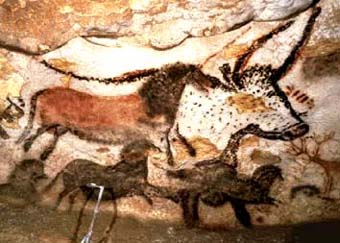
The First Bull - from Lascaux in the Great
Hall of the Bulls - 13,000 BCE
http://www.culture.gouv.fr/culture/arcnat/lascaux/en/
Events that shaped the arts from
the beginning of humans until 400 BCE.
2.5 million BCE - Earliest tools made by the Homo habilis
(HM, p. 98).
150,000 BCE - Earliest finds of modern man (Africa)
(http://www.hyperhistory.com/online_n2/History_n2/a.html)
70,000 BCE - Humans begin to use clothing (http://www.hyperhistory.com/online_n2/History_n2/a.html)
9,000 BCE - The development of agriculture began with the
growing of crops and the domestication of animals in the Middle East
(HM, p. 498).
4,000 BCE - People begin to settle along the Nile River
(HM, p. 184).
3,500 BCE - Sumerians, who lived in southern Mesopotamia,
invent the wheel and the sailboat to help them transport goods (HM,
p. 148).
3,500 BCE - Sumerians invented the first form of writing,
cuneiform or simplified wedge-shaped characters (HM, p. 498).
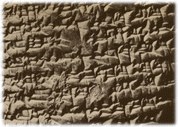
The first pictograms were drawn in vertical columns with a pen made
from a sharpened reed. Then two developments made the process quicker
and easier: People began to write in horizontal rows, and a new type
of pen was used which was pushed into the clay, producing
"wedge-shaped" signs that are known as cuneiform writing. (http://www.upenn.edu/museum/Games/cuneiform.html)
Top

http://guardians.net/egypt/sphinx/
c.2555-2532 BCE - The Pyramids and Great Sphinx were built
in Giza, Egypt (HM, p. 498).
The Sphinx Controversy - A research team has discovered
physical evidence that the Great Sphinx of Giza, Egypt, may date from
5000 and 7000 BCE and possibly earlier. In response, archaeologists
have thrown mud at geologists, historians have been caught in the
middle, and the Sphinx, having revealed one secret, challenges us to
unravel even greater ones. http://members.aol.com/davidpb4/sphinx1.html
2,500 BCE - The Epic of Gilgamesh and the Epic of
Creation, the oldest epic poems in world literature, were written
in Mesopotamia (HM, p. 498).
2,300's BCE - Sargon of Akkad conquered the Sumerians and
united all Mesopotamia under his rule, creating the world's first
empire (HM, p. 498)
1700's BCE - The Code of Hammurabi, one of the fist law
codes, was drawn up (HM, p. 498).
1700's BCE - Judaism was founded (HM, p. 498).
Top
700's BCE - The Greek epic poems the Iliad and the
Odyssey were composed (HM, p. 498).
776 BCE - First recorded Olympic Games were held in Greece
(HM, p. 499).
500's BCE - The Hanging Gardens of Babylon were built (HM,
p. 499).
400's BCE - Hippocrates showed that diseases have natural
causes (HM, p. 499).
Egyptian
Art
In Egyptian art, there was a strong sense of order, form and
symbolism (certain items held certain meanings). The paintings
especially were highly stylized and they told a story. The style of
art in Egypt didn't change for three thousand years in part because
the artists quite simply obeyed the rules set out for them.
Ancient Egyptian history and art can be divided up into the
following periods:
- Lower Paleolithic (c. 2 Million - 100000 BCE)
- Middle Paleolithic (100000 - 30000 BCE)
- Upper Paleolithic (30000 - 10000 BCE)
- Epipaleolithic Era (10000 - c. 5500 BCE)
- Predynastic Period (5500 - 3100 BCE)
- 1st Dynasty (2920 - 2770 BCE)
- 2nd Dynasty (2770 - 2650 BCE)
- 3rd Dynasty (2650 - 2575 BCE)
- 4th Dynasty (2575 - 2467 BCE)
- 5th Dynasty (2465 - 2323 BCE)
- 6th Dynasty (2323 - 2152 BCE)
- First Intermediate Period
(7th - 11th Dynasties) (2150 -1986 BCE)
- 11th Dynasty (1986 - 1937 BCE)
- 12th Dynasty (1937 - 1759 BCE)
- Second Intermediate Period
(13th - 17th Dynasties) (1759 - 1539 BCE)
- 18th Dynasty (1539 - 1295 BCE)
- 19th Dynasty (1295 - 1186 BCE)
- 20th Dynasty (1186 - 1069 BCE)
- 21st Dynasty (1070 - 945 BCE)
- 22nd Dynasty (945 - 712 BCE)
- 23rd Dynasty (828 - 725 BCE)
- 24th Dynasty (725 - 715 BCE)
- 25th Dynasty (712 - 657 BCE)
- 26th Dynasty (664 - 525 BCE)
- 27th Dynasty (525 - 404 BCE)
- 28th Dynasty (404 - 399 BCE)
- 29th Dynasty (399 - 380 BCE)
- 30th Dynasty (380 - 343 BCE)
- 31st Dynasty (343 - 332 BCE) (http://www.touregypt.net/ehistory.htm)
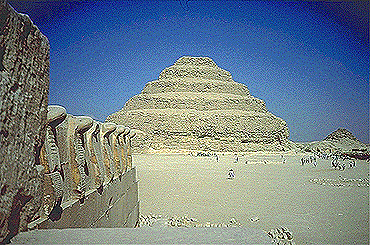
The Step Pyramid of King Djoser of the
Old Kingdom - designed for King Djoser (Dynasty 3) by his vizier
Imhotep. The pyramid is located in Saqqara, the main necropolis of
Memphis. -
http://www.memphis.edu/egypt/saqqara.htm
Top
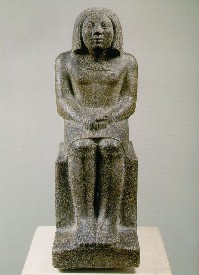
Ankh seated with hands clasped - Third Dynasty, reign of
Djoser - Gray porphyroid granite -
http://www.artchive.com/artchive/E/egyptian/egyptian_3_ankh.jpg.html
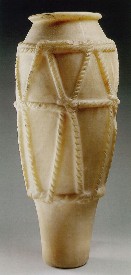
Vase with rope decoration - Third Dynasty - Egyptian alabaster
-
http://www.artchive.com/artchive/E/egyptian/egyptian_3_vase.jpg.html
Top
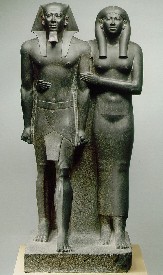
King Menkaure and a Queen - Fourth Dynasty, reign of Menkaure
- Graywacke with faint remains of paint -
http://www.artchive.com/artchive/E/egyptian/egyptian_4_menkaure.jpg.html
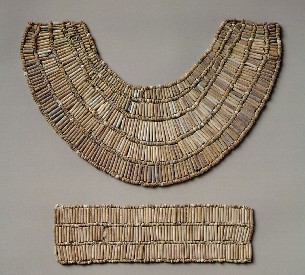
Broad collar and ankle bracelet - Fifth Dynasty - Egyptian
faience -
http://www.artchive.com/artchive/E/egyptian/egyptian_5_collar_ankle.jpg.html
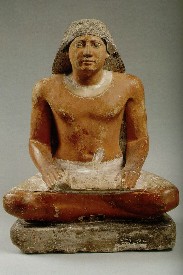
Scribe - Fifth Dynasty - Painted limestone -
http://www.artchive.com/artchive/E/egyptian/egyptian_5_scribe.jpg.html
Top
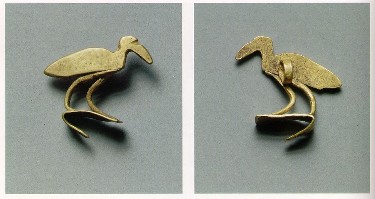
Amulet in the shape of an ibis - End of Old Kingdom - Gold
-
http://www.artchive.com/artchive/E/egyptian/egyptian_6_ibis.jpg.html
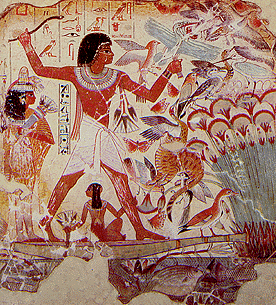
This noble is spending his leisure time hunting fowl with his
cat. His wife accompanies him, as many women did. Notice that the
birds, and especially the fish, are painted very realistically, with
attention paid to the slightest details, while the humans conform to
the cartoon-like frontalistic style - Understanding Egyptian
Art - (http://www.bergen.org/AAST/Projects/Egypt/art%5Freport.html)
Top

Heart scarabs of three wives of Thutmosis
III -
http://www.bugbios.com/ced2/heart.html
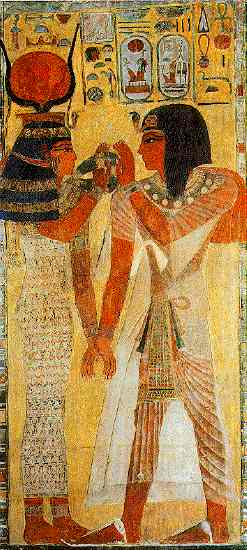
The goddess Hathor and King Seti I - from the tomb of Seti I,
Valley of the Kings, circa 1301-1290 BCE -
http://www.paris.org/Musees/Louvre/Treasures/Egyptian/
Top
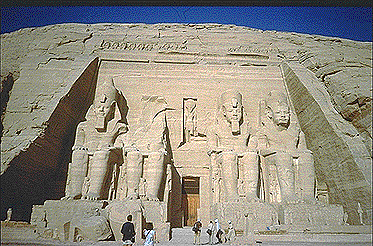
Abu Simbel - a temple built by Ramesses II
(c.1279-1213 B.C.E.) in ancient Nubia -
http://www.memphis.edu/egypt/abusimbe.htm
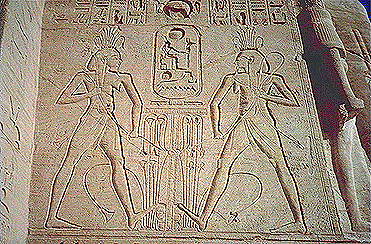
Sunk relief of the God Hapy - sunk relief of
the god Hapy, the personification of the Nile flood -
http://www.memphis.edu/egypt/abusimbe.htm
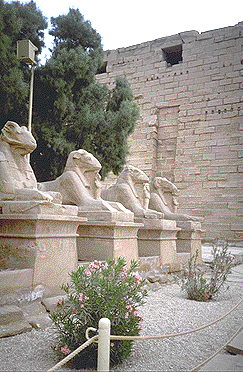
Sphinxes at Thebes - Many of the main roads
which lead to the temples of Thebes (modern Luxor) used to be
continuously lined with sphinxes. -
http://www.memphis.edu/egypt/luxortm.htm
Top

Mummy covering - painted and pasted cloth, 800 BCE -
http://www.paris.org/Musees/Louvre/Treasures/Egyptian/
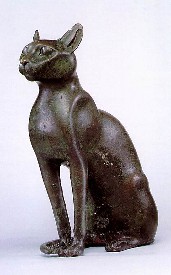
Coffin for a Sacred Cat - Ptolemaic period, 304-30 BCE -
Bronze -
http://www.artchive.com/artchive/E/egyptian/sacred_cat.jpg.html
Indian
Art
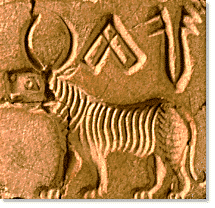
India's Indus
script -
http://www.harappa.com/script/maha0.html
Kamat's Potpourri: Timeline of Indian Art - http://www.kamat.com/kalranga/art/timeline.htm
- Paintings, architecture and fine art in India through the
centuries.
Historical and Cultural
Context | Site
Map | On-Line
Resources | Rules
of Thumb | Glossary
| Quotes
| WordList
| Co-Teachers - Doug
and Melissa
| Gallery
| Top
E-Mail Doug at mrdoug@aznet.net
or Melissa at mjmckinstry@earthlink.net
|
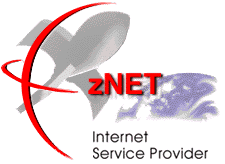
|
Melissa and I would like to
thank znet
for
making a commitment to
education and WriteDesign.
|




















